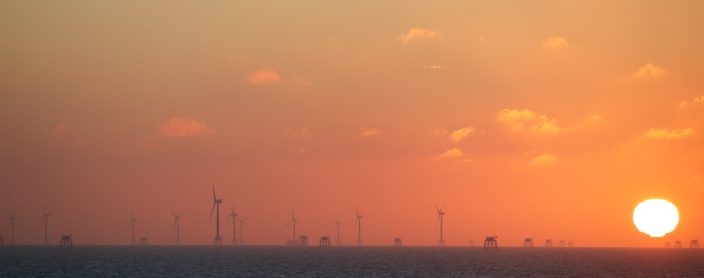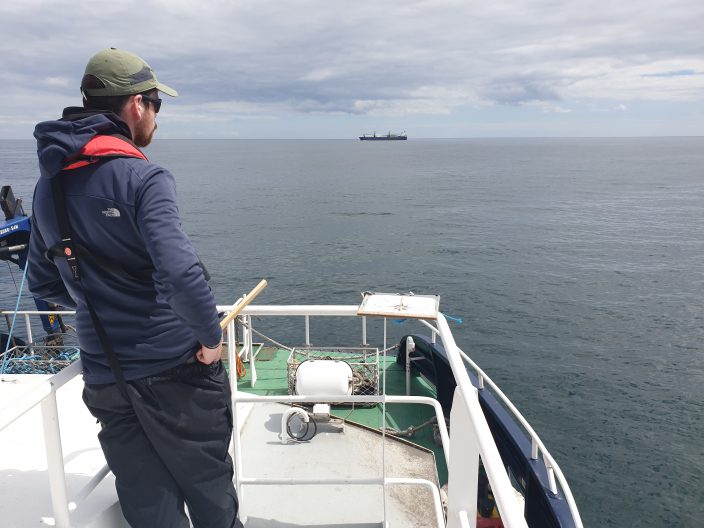The expansion of offshore renewable energy (ORE) into the marine environment is one of the most potentially significant developments in Irish coastal waters. If the government reach their target of 5GW of offshore wind energy built by 2030 and 20GW by 2040, we will see hundreds of turbines, both fixed and floating, deployed in our coastal waters. The IWDG support renewable energy as Ireland attempts to de-carbonise its economy and acknowledge offshore renewables will be part of this transition.
The ecological impacts of this development on cetaceans (whales, dolphins and porpoise) and their habitats are not clear. If constructed in important habitats, for example foraging or calving areas, or constructed without appropriate techniques to mitigate impacts, such as impulsive noise generated during piling, the impacts could be very negative. If offshore wind farms are developed with associated ecological enhancement such as rehabilitation of benthic habitats, enhanced fish diversity and operate as de facto no-take areas, with activities such as trawling restricted, they can have positive impacts on cetaceans.
The evidence from offshore wind farms developed elsewhere is mixed. At some sites in the North Sea, even with appropriate mitigation there was long-term displacement of harbour porpoises from the immediate area,[1] whilst at other sites harbour porpoise activity recovered within months of construction[2]. Responses of seals to pile driving also differed, with harbour seal showing very slow recovery at a haul out site post-construction[3]. There is recent empirical evidence that offshore platforms may act as artificial reefs, thus providing enhanced foraging opportunities for harbour porpoise, suggesting a “reef effect”[4].
Clearly it is essential to build robust and high resolution baseline line datasets in Irish habitats with Irish cetacean communities, which are more diverse and typically have greater abundance than at sites in the North Sea or off NE Scotland, to accurately describe those species potentially affected and to enable any short or long term changes to be measured to inform future management and mitigation.
Reports of the death of large numbers of baleen whales in the United States due to offshore wind developments is “fake news”. This fake news has spread to Australia recently and needs to be called out for what it is.
Reports from the US attributing the death of large baleen whales washing up along the east coast to offshore wind developments are simply false. Large whales have been washing up in increasing numbers for years, with many deaths when investigated attributed to entanglement in fishing gear or ship collisions. Geophysical and geotechnical investigations associated with offshore wind development, as is occurring off the western Atlantic, is not outright killing large whales. Without mitigation, geophysical surveys could compromise their hearing if too close, but even if that occurred this impact would be chronic, leading to long term negative effects, not a catastrophic impact resulting in death.
What are the IWDG doing on ORE in Ireland
The IWDG have been at the forefront of championing environmental issues related to offshore renewables for many years. Since 2009 we have worked with SEAI to establish baseline marine mammal activity indices at the two offshore test sites in readiness for devices to be deployed and prepared guidance documents. In 2020 we published an Offshore Wind Farm Policy Document (https://iwdg.ie/iwdg-publish-offshore-windfarm-policy-to-ensure-impacts-on-marine-mammals-are-kept-at-a-minimum/), the first eNGO in Ireland to present our opinions on the subject and identify key issues. It was welcomed by industry and Wind Energy Ireland (WEI) as an opportunity to discuss and debate potential impacts of offshore renewable activities. After publication of this policy document the IWDG held a large number of on-line consultations with industry explaining our concerns and listening to their responses. It was a positive exercise and enabled IWDG raise our concerns early on in the planning process.
Currently the planning and development of offshore renewables has moved from an industry to a government led approach. The IWDG welcomes this. We are working with the Department of the Environment, Climate and Communication (DECC) on the South Coast Designated Maritime Area Plan (DMAP), both through the consultation process and direct communication. We have recently shared our unique database of more than 22,000 cetacean sightings to ensure important cetacean habitats are considered when creating DMAPs. These DMAPs will identify areas that are appropriate for ORE and we want to ensure they avoid areas we know to be important for cetaceans.
Current work involving the ORE sector
There are a large number of scoping documents for proposed offshore wind farms in circulation for comment, and by June 2024 a suite of environmental impact assessments (EIA) will be submitted to An Bord Pleanála as part of planning applications; these will require considered responses. The EIAs will be associated with phase I applicants, who have recently been awarded a marine area consent (MAC), five off the east coast and one off Co. Galway.
IWDG sits on the Offshore Renewable Energy Development Programme (OREDPII) and Marine Task Force Stakeholders Group. We have prepared and submitted opinions to the Marine Area Consent Consultation, Offshore Wind Farm Consultation, parts I and II, ORESS, OREDP II, the South Coast DMAP, and the Shannon Estuary Economic Task Force to name but a few. In 2023 alone we have made nine submissions on ORE scoping reports and foreshore license applications. The IWDG are the only eNGO with this level of engagement with industry and the government. IWDG believe that now is the time to represent cetaceans and their habitats and engage in the process. We strive to include our concerns and recommendations in the process now, while the opportunity arises and before the process of licensing ORE is too far advanced. This is we feel the right approach.
IWDG Consulting for the ORE
The IWDG’s first involvement in offshore renewables were baseline surveys at the Atlantic Marine Energy Site (AMETS) off Co. Mayo and at the quarter-size test facility off Spiddal in Galway Bay. IWDG, through IWDG Consulting, won the tender from Sustainable Energy Authority of Ireland (SEAI) to provide baseline data with which to measure any impacts on marine mammals once ORE devices were deployed. Following the experience gained from this work, IWDG were contracted to prepare the marine mammal section of the SEAI Guidance on EIS and NIS Preparation for ORE Projects. This was an opportunity to ensure robust baseline surveys, including acoustics, were required by all those seeking to develop ORE.
We recently also won the contract to carry out similar surveys for the SEAI AFLOWT project, which aimed to have a full-scale offshore wind device deployed at AMETS in 2023. However, due to the uncertainty in the Irish planning system, the deployment site moved from AMETS to France. IWDG still delivered the work including static acoustic monitoring, RIB based photo-id surveys and modelling of impulsive sounds associated with pin piling. This project promotes best practice in environmental assessment and an opportunity to test methods and assumptions ahead of full-scale rollout of ORE.
Between 2019-2020, IWDG Consulting carried out boat-based marine mammal visual surveys of proposed OWFs off Co. Louth and Co. Waterford. These surveys are now carried out by digital aerial surveys and are no longer boat-based. IWDG have expressed concerns over the suitability of aerial surveys for monitoring marine mammals, compared to boat-based surveys. We are currently working with Green Rebel Marine to validate aerial survey imagery for marine mammal identification. Interestingly, harbour porpoise density estimates determined during IWDG Consulting surveys are always much higher than those estimated by other survey companies or from aerial surveys. IWDG Consulting only carry out surveys when sea conditions are favourable, choose the best platforms and use only experienced observers. We set the standards for the industry to follow.
We have carried out static acoustic monitoring surveys (SAM) off Co. Louth and currently off Co. Wexford and Co. Waterford for three proposed ORF. SAM is a powerful technique to assess the use of a site, especially for harbour porpoises which are hard to detect visually. IWDG has proposed SAM should be carried out for at least 2 years prior to construction of an offshore wind farm, should be maintained during construction and for at least 2 years post construction (if not throughout the life of the OWF). The surveys off Wexford and Waterford are some of the first SAM surveys to inform site selection in Ireland and we have developed a novel survey design and deployment method which we hope will be used as a standard for future SAM at other sites. This experience leaves IWDG well-positioned when reviewing environmental impact and scoping documents and making recommendations to government and industry.
IWDG Consulting charges for its services and the surplus from these contracts fund our Marine Policy Officer to review scoping and environmental assessments, liaise with industry and government, attend meetings and prepare opinion pieces and submissions.
In summary …
The IWDG are fully engaging with ORE in Ireland, both at an industry and government level. IWDG data on cetacean distribution consistently reflect the same trends that have been identified worldwide, i.e. where species distributions are moving north following prey that are seeking colder sea temperatures in increasingly warmer oceans. The world needs to reduce its carbon output from fossil fuels to halt and ultimately reverse global warming which could lead to climate chaos. The IWDG is being proactive in identifying key issues for cetaceans and their habitats in Ireland, ensuring our concerns are addressed at all levels, and recommending monitoring, mitigation and management. We believe at this early stage in the process that this is the right approach. Much of our engagement is not headline seeking, plastered all over social media or possibly in line with the approach of other eNGOs. But is the IWDG approach effective? While we feel it is, ultimately only time will tell. In the meantime we endeavour to engage, learn and protect as much as possible.’
Dr Simon Berrow
Also see https://iwdg.ie/the-marine-renewables-sector-is-operating-within-an-environmental-vacuum/
[1] Teilmann, J. and Carstensen, J. (2012) Negative long-term effects on harbour porpoises from a large-scale offshore wind farm in the Baltic—evidence of slow recovery. Environ. Res. Lett. 7 045101
[2] Vallejo, G.C., Grellier, K., Nelson, E.J., et al. (2017) Responses of two marine top predators to an offshore wind farm. Ecol Evol. 7: 8698–8708. https://doi.org/10.1002/ece3.3389
[3] Skeate, E.R., Perrow, M.R., Gilroy, J.J. (2012) Likely effects of construction of Scroby Sands offshore wind farm on a mixed population of harbour Phoca vitulina and grey Halichoerus grypus seals. Marine Pollution Bulletin, 64 (4),872-881, https://doi.org/10.1016/j.marpolbul.2012.01.029.
[4] Oihane, F-B., Graham, I. and Thompson, P. (2022). Reef effect of offshore structures on the occurrence and foraging activity of harbour porpoises. Frontiers in Marine Science. 9. 10.3389/fmars.2022.980388.



